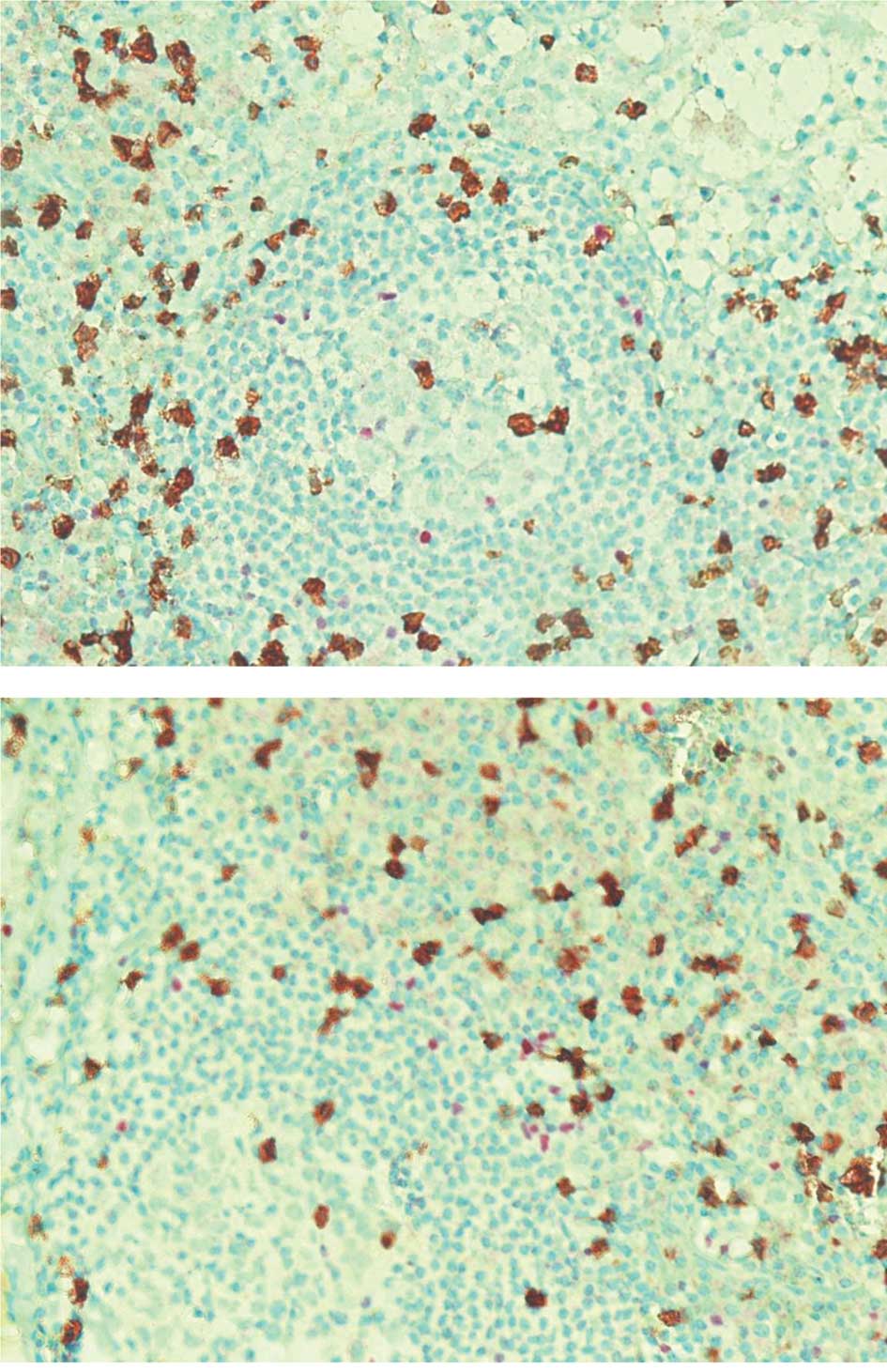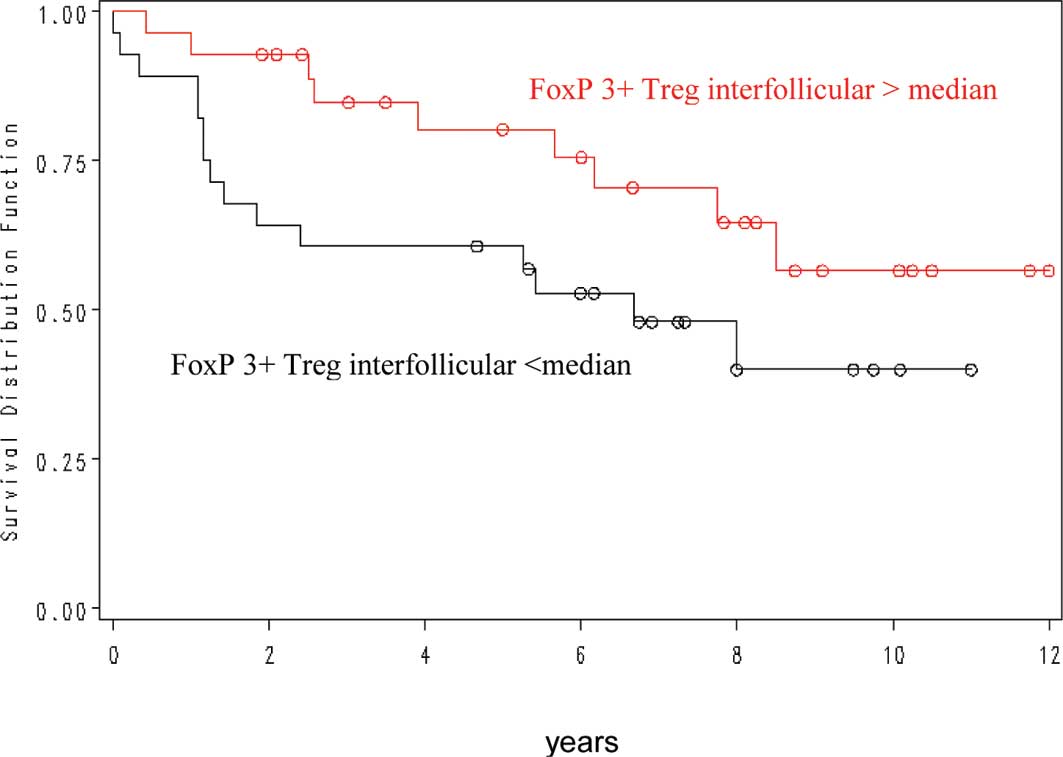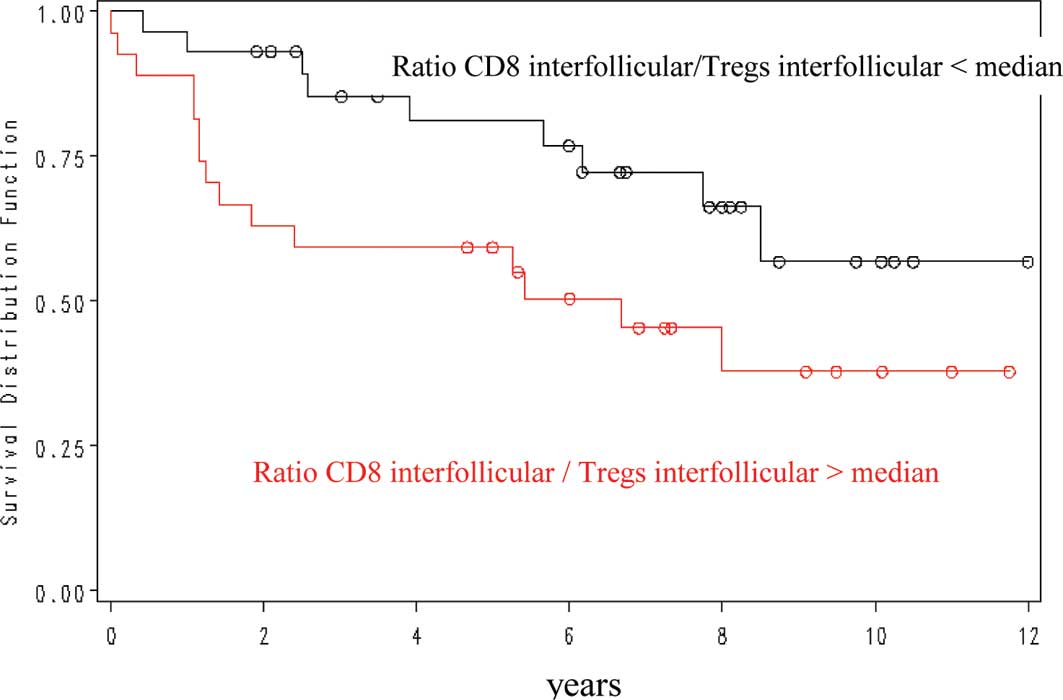|
1.
|
Tsujimoto Y, Cossman J, Jaffe E and Croce
CM: Involvement of the bcl-2 gene in human follicular lymphoma.
Sciences. 228:1440–1443. 1985. View Article : Google Scholar : PubMed/NCBI
|
|
2.
|
Clearly ML and Sklar J: Nucleotide
sequence of t(14,18) chromosomal breakpoint in follicular lymphoma
and demonstration of a breakpoint-cluster region near a
transcriptionally active locus on chromosome 18. Proc Natl Acad Sci
USA. 82:7439–7443. 1995. View Article : Google Scholar
|
|
3.
|
Solal-Céligny P, Roy P, Colombat P, White
J, Armitage JO, Arranz-Saez R, Au WY, Bellei M, Brice P, Caballero
D, Coiffier B, Conde-Garcia E, Doyen C, Federico M, Fisher RI,
Garcia-Conde JF, Guglielmi C, Hagenbeek A, Haïoun C, LeBlanc M,
Lister AT, Lopez-Guillermo A, McLaughlin P, Milpied N, Morel P,
Mounier N, Proctor SJ, Rohatiner A, Smith P, Soubeyran P, Tilly H,
Vitolo U, Zinzani PL, Zucca E and Montserrat E: Follicular Lymphoma
International Prognostic Index. Blood. 104:1258–1265. 2004.
|
|
4.
|
Lossos IS and Levy R: Higher-grade
transformation of follicle center lymphoma is associated with
somatic mutation of 5′ noncoding regulatory region of Bcl-6 gene.
Blood. 96:635–639. 2000.
|
|
5.
|
Küppers R: Prognosis in follicular
lymphoma – it’s in the microenvironment. N Engl J Med.
351:2152–2153. 2004.
|
|
6.
|
Natkunam Y: The biology of germinal
center. Hemat Am Soc Hematol Educ Program. 210–215. 2007.
View Article : Google Scholar
|
|
7.
|
Amé-Thomas P, Maby-El Hajjami H, Monvoisin
C, Jean R, Monnier D, Caulet-Maugendre S, Guillaudeeux T, Lamy T,
Fest T and Tarte K: Human mesenchymal stem cells isolated from bone
marrow and lymphoid organs support tumor B-cell growth: role of
stromal cells in follicular lymphoma pathogenesis. Blood.
109:693–702. 2007.PubMed/NCBI
|
|
8.
|
Herreros B, Sanchez-Aguilera A and Piris
MA: Lymphoma microenvironment: culprit or innocent. Leukemia.
22:49–58. 2008. View Article : Google Scholar : PubMed/NCBI
|
|
9.
|
Carbone A, Gloghini A, Cabras A and Elia
G: Differentiating germinal center-derived lymphomas through their
cellular microenvironment. Am J Haematol. 84:435–438. 2009.
View Article : Google Scholar : PubMed/NCBI
|
|
10.
|
Staudt LM and Dave S: The biology of human
lymphoid malignancies revealed by gene expression profiling. Adv
Immunol. 87:163–208. 2005. View Article : Google Scholar : PubMed/NCBI
|
|
11.
|
Dave SS, Wright G, Tan B, Rosenwald A,
Gascoyne RD, Chan WC, Fisher RI, Braziel RM, Rimsza LM, Grogan TM,
Miller TP, LeBlanc M, Greiner TC, Weisenburger DD, Lynch JC, Vose
J, Armitage JO, Smeland EB, Kvaloy S, Holte H, Delabie J, Connors
JM, Lansdorp PM, Ouyang Q, Lister TA, Davies AJ, Norton AJ,
Muller-Hermelink HK, Ott G, Campo E, Montserrat E, Wilson WH, Jaffe
ES, Simon R, Yang L, Powell J, Zhao H, Goldschmidt N, Chiorazzi M
and Staudt LM: Prediction of survival in follicular lymphoma based
on molecular features of tumor-infiltrating immune cells. N Engl J
Med. 351:2159–2169. 2004. View Article : Google Scholar : PubMed/NCBI
|
|
12.
|
Woo EY, Chu CS, Goletz TJ, et al:
Regulatory CD4+ CD25+ T cells in tumors from
patients with early-stage non-small cell lung cancer and late-stage
ovarian cancer. Cancer Res. 61:4766–4772. 2001.PubMed/NCBI
|
|
13.
|
Shevach EM: Mechanisms of
foxp3+ T regulatory cell-mediated suppression. Immunity.
30:636–645. 2009.
|
|
14.
|
Farinha P, Al-Tourah A, Gill K, Klasa R,
Connors JM and Gascoyne RD: The architectural pattern of
FOXP3-positive T cells in follicular lymphoma is an independent
predictor of survival and histologic transformation. Blood.
115:289–295. 2010. View Article : Google Scholar : PubMed/NCBI
|
|
15.
|
Lee AM, Clear AJ, Calaminici M, Davies AJ,
Jordan S, MacDougall F, Matthews J, Norton AJ, Gribben JG, Lister
TA and Goff LK: Numbers of CD4+ cells and location of
forkhead box protein-P3-positive cells in diagnostic follicular
lymphoma tissue microarrays correlates with outcome. J Clin Oncol.
24:5052–5059. 2006.
|
|
16.
|
Tzankov A, Meier C, Hirschmann P, Went P,
Pileri SA and Dirnhofer S: Correlation of high numbers of
intratumoral FoxP3 regulatory T cells with improved survival in
germinal center-like diffuse large B-cell lymphoma, follicular
lymphoma and classical Hodgkin’s lymphoma. Haematologica.
93:193–200. 2008.PubMed/NCBI
|
|
17.
|
Carreras J, Lopez-Guillermo A, Fox BC,
Colomo L, Martinez A, Roncador A, Montserrat E, Campo E and Banham
AH: High numbers of tumors-infiltrating FoxP3-positive regulatory T
cells with improved overall survival in follicular lymphoma. Blood.
108:2957–2964. 2006. View Article : Google Scholar : PubMed/NCBI
|
|
18.
|
Glas AM, Kersten MJ, Delahaye L, Witteveen
AT, Kibbelaar RE, Velds A, Wessels LA, Joosten P, Kerkhoven RM,
Bernards R, Van Krieken JH, Kluin PM, van’t Veer LJ and de Jong D:
Gene expression profiling in follicular lymphoma to assess clinical
aggressiveness and to guide the choice of treatment. Blood.
105:301–307. 2005. View Article : Google Scholar : PubMed/NCBI
|
|
19.
|
Engelbrekt W, Sander B, Christensson B and
Kimby E: CD8+ T-cell content in diagnostic lymph nodes
measured by flow cytometry is a predictor of survival in follicular
lymphoma. Clin Cancer Res. 13:388–397. 2007.
|
|
20.
|
Taskinen M, Karjalainen-Lindsberg ML and
Leppä S: Prognostic influence of tumor-infiltrating mast cells in
patients with follicular lymphoma treated with rituximab and CHOP.
Blood. 111:4664–4667. 2008. View Article : Google Scholar : PubMed/NCBI
|
|
21.
|
Alvaro T, Lejeûne M, Salvado MT, Lopez C,
Jaén J and Bosch R: Immunohistochemical patterns of reactive
microenvironment are associated with clinicobiologic behavior in
follicular lymphoma patients. J Clin Oncol. 24:5350–5357. 2006.
View Article : Google Scholar : PubMed/NCBI
|
|
22.
|
Taskinen M, Karjalainen-Lindsberg ML,
Nyman H, Eerola LM and Leppä S: A high tumor-associated macrophage
content predicts favorable outcome in follicular lymphoma patients
treated with rituximab and
cyclophosphamidedoxorubicin-vincristine-prednisone. Clin Cancer
Res. 13:5784–5789. 2007. View Article : Google Scholar
|
|
23.
|
Canioni D, Salles G, Mounier N, Brousse N,
Keuppens M, Morchhausser F, Lamy T, Sonnet A, Rousselet MC,
Foussard C and Xerri L: High numbers of tumor-associated
macrophages have an adverse prognostic value that can be
circumvented by rituximab in patients with follicular lymphoma
enrolled onto the GELA-GOELAMS FL-2000 trial. J Clin Oncol.
26:440–446. 2008. View Article : Google Scholar
|
|
24.
|
Swerrdlow SH, Campo E, Lee Harris N, Jaffe
E, Pileir A, Stein H, Thiel J and Vardiman J: WHO Classification of
Tumours of Haematopoietic and Lymphoid Tissues. (4th edition).
International Agency for Research on Cancer. 2008.
|
|
25.
|
Ai W, Hou JZ, Zeiser R, Czerwinski D,
Negrin RS and Levy R: Follicular lymphoma B cells induce the
conversion of conventional CD4+ cells to T-regulatory
cells. Int J Cancer. 124:239–244. 2008. View Article : Google Scholar : PubMed/NCBI
|
|
26.
|
Alvaro T, Lejeune M, Salvado MT, Bosch R,
Garcia JF, Jaén J, Banham AH, Roncador G, Montalban C and Piris M:
Outcome in Hodgkin’s lymphoma can be predicted from the presence of
accompanying cytotoxic and regulatory T cells. Clin Cancer Res.
11:1467–1473. 2005.
|
|
27.
|
Chetaille B, Bertucci F, Finetti P,
Esterni B, Stamatoullas A, Picquenot JM, Copin MC, Morschhauser F,
Casasnovas O, Petrella T, Molina T, Vekhoff A, Feugier P,
Bouabdallah R, Birnbaum D, Olive D and Xerri L: Molecular profiling
of classical Hodgkin lymphoma tissues uncovers variations in the
tumor microenvironment and correlations with EBV infection and
outcome. Blood. 113:2765–3775. 2009. View Article : Google Scholar : PubMed/NCBI
|
|
28.
|
De Jong D, Koster A, Hagenbeek A,
Reameakers J, Veldhuizen D, Heisterkamps S, De Boer JP and
Vanglabeeke M: Impact of tumor microenvironment on prognosis in
follicular lymphoma is dependent on specific treatment protocols.
Haematologica. 94:70–77. 2009.PubMed/NCBI
|
|
29.
|
Glas AM, Kersten MJ, Delahaye LJ,
Witteveen AT, Kibbelaar RE, Velds A, Wessels LF, Joosten P,
Kerkhoven RM, Bernards R, van Krieken JH, Kluin PM, van ‘t Veer LJ
and De Jong D: Gene-expression and immunohistochemical study of
specific T-cell subsets and accessory cell types in the
transformation and prognosis of follicular lymphoma. J Clin Oncol.
25:390–398. 2007. View Article : Google Scholar : PubMed/NCBI
|
|
30.
|
De Jong D: Molecular pathogenesis of
follicular lymphoma: A cross talk of genetic and immunologic
factors. J Clin Oncol. 23:6358–6363. 2005.PubMed/NCBI
|
|
31.
|
Kelley T, Beck R, Absi A, Jin T, Pohlman B
and Hsi E: Biologic predictors in follicular lymphoma: importance
of markers of immune response. Leuk Lymphoma. 48:2403–2411. 2007.
View Article : Google Scholar : PubMed/NCBI
|
|
32.
|
Glas AM, Kersten MJ, Delahaye LJ,
Witteveen AT, Kibbelaar RE, Velds A, Wessels LF, Joosten P,
Kerkhoven RM, Bernards R, van Krieken JH, Kluin PM, van ‘t Veer LJ
and de Jong D: Prognostic significance of host immune gene
polymorphisms in follicular lymphoma survival. Blood.
109:5439–5446. 2007. View Article : Google Scholar : PubMed/NCBI
|

















